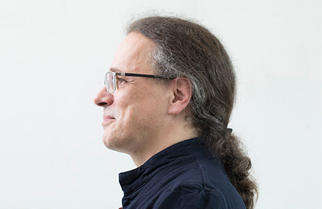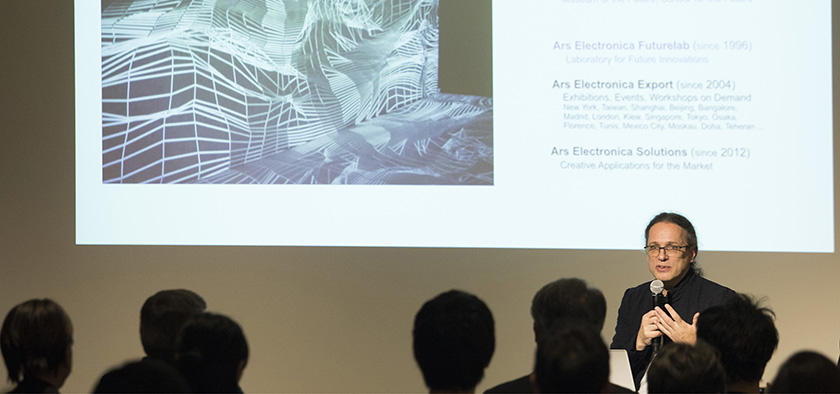
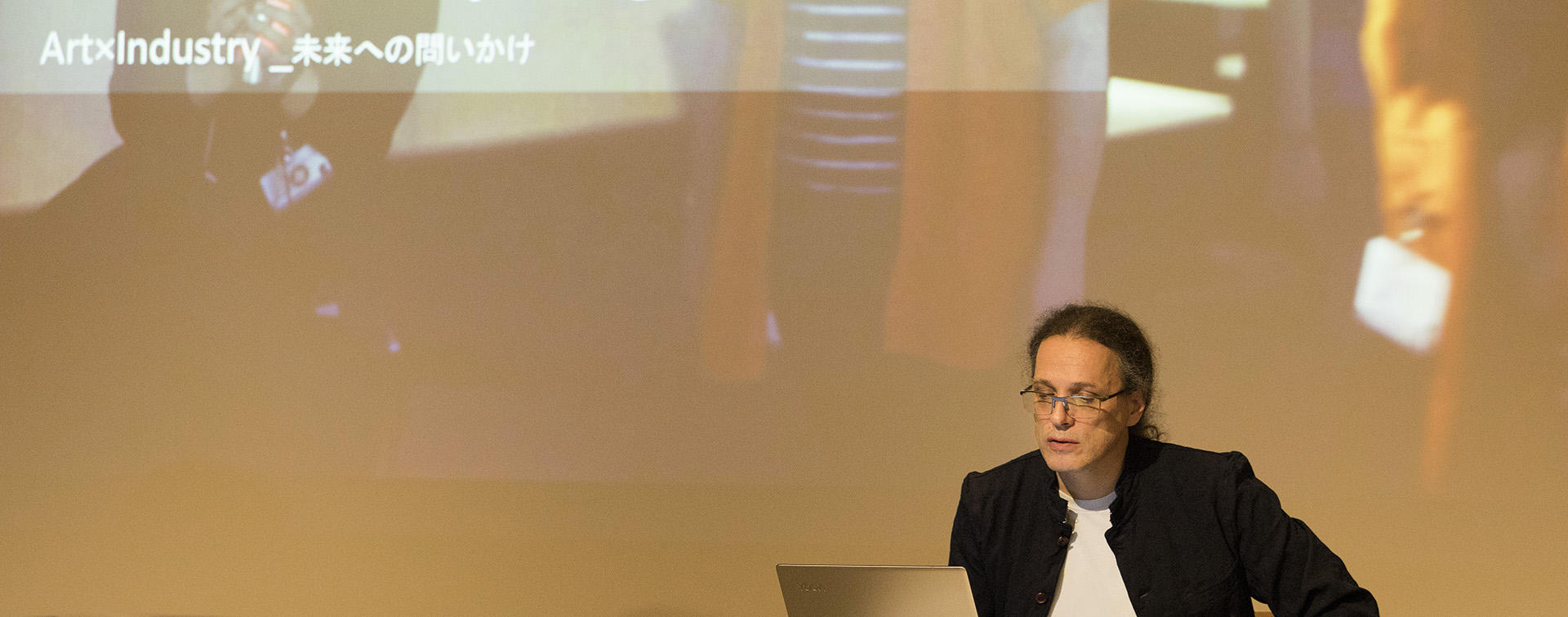
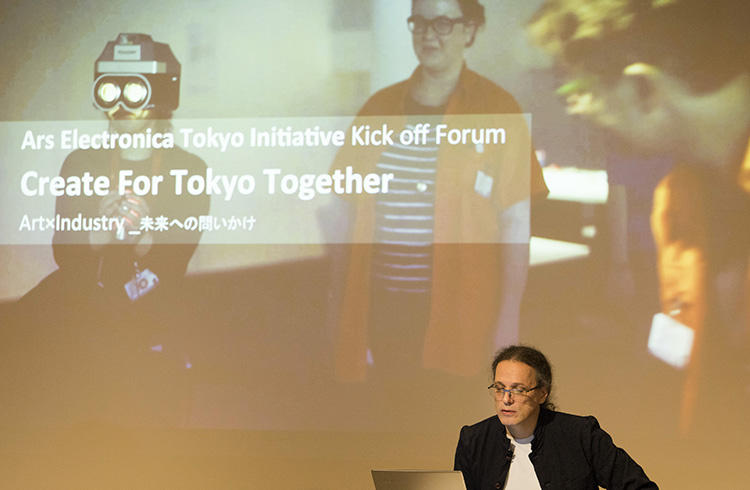
Creating Rppongi's future by asking the right questions
Programming and algorithms are languages for understanding the world
The text below is not a transcript but a translation of the interview held in Japanese. The Ars Electronica festival started in 1979 in the Austrian city of Linz. It is an artistic festival where one can get a glimpse of the future, and draws strong attention from artists, researchers and corporations worldwide. We interviewed Gerfried Stocker, artistic director at Ars Electronica, the institute which holds the festival; he told us about his views on how art and technology could pave the way for Roppongi's future, and what kind of studies will be useful for the future.
Tokyo - the world's most interesting place for social experimentation
The first time I came to Tokyo was about 20 years ago. I've since visited every year for various reasons. For me, Tokyo is the most interesting place on earth for social experimentation. Compared to other global cities, it has an exceedingly high population density and it is remarkable - even when you think of Japan as a whole - how such large numbers of people are concentrated here in Tokyo. Every time I visit, I am excited by the fact that there is a harmonious co-existence between the city environment and the technology and activities of the people.
On the other hand, the city of Tokyo is overflowing with commercialism. This is an aspect which I personally regard as a problem. For instance, the commercialism is clearly visible when you stand at the intersection in front of Shibuya station. Almost all the surrounding buildings and shopping malls are covered with advertisements. When I see such scenery, I get the feeling that public space in Tokyo is being kept for marketing and advertising.

Ars Electronica
Ars Electronica began operations in 1979 in Linz, Austria and has become an international hub in the genres of digital art and media culture; its operations are divided into four departments, one of which is running the Ars Electronica Festival every year in September. The institute's other three departments are the Ars Electronica Center which is a museum and educational center, a media art research and development facility called Future Lab, and giving of the Prix Ars Electronica which is aimed at developing a network of artists around the world.
Developing towns by utilizing public space
I think Tokyo people should give more thought to the use of public space in cities. It is by utilizing public space that the creativity and future of towns can be developed. Every year in early September, Ars Electronica festival is held for several days in Linz, Austria. I serve as a director of this festival and public space in the city such as open spaces, parks and shopping malls in the urban areas are used as the venues. Instead of packaging things and showing them in a museum, we place things in public spaces where the lives of the people are. By doing this, we can make art and technology more accessible to all kinds of people. It also leads to new encounters and dialogues.
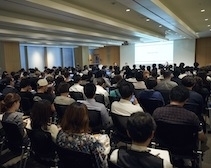
Ars Electronica Tokyo Initiative Kick Off Forum
Stocker arrived in Japan on May 25 to attend the Ars Electronica Tokyo Initiative Kick Off Forum in Tokyo Midtown. The Ars Electronica Tokyo Initiative is an "innovation creating community" jointly launched by Ars Electronica and Hakuhodo Inc.. The word "initiative" means vanguard, leading and taking the first step. The community says its mission is to improve Tokyo and Japanese society; members including corporations, innovators and artists convene to think of new ideas and implement them for the creation of a future society. (Credit: Ars Electronica Tokyo Initiative / Hitoshi Motomura)
Linz is a small city with a population of around 200,000. The good thing about undertaking activities in a small city like Linz is that compared to a bigger city, it is easier to get messages across to people. We live in times where artists are beginning to move dynamically in society; after making their works, artists are expected to interact with others instead of withdrawing into themselves.
I have seen many citizens become active players in developing the city of Linz through the festival. What is the situation in Tokyo? Perhaps you should move away from protected spaces, and make the whole city a stage. I think that is one way of unleashing the potential in Tokyo.

From the perfect to the imperfect
Speaking of technology, the high-rise buildings in Tokyo are practical and functional; they are perfectly maintained structures, and below these buildings, the subway trains run perfectly on time. When you place yourself in this kind of space where everything is integrated for the purpose of working, you realize that the high-rise buildings and the subways embody the technology of Tokyo. On the other hand, if you go to the subways in Manhattan, you get the feeling that you have slipped back in time a 100 years. Everything is in place in Tokyo - as if in science fiction; the city is a place for social experimentation - it is like a science laboratory.
That is why one sometimes gets the sense that Tokyo is too perfect. And the people who live in Tokyo work with machine-like precision. I think that in the future, Tokyo is going to explore ways to escape from this excessive perfection; there will probably be an instinctive shift toward things that are not perfect.
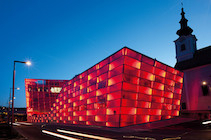
Linz
With a population of 200,000, Linz is Austria's third largest city after Vienna and Graz and the country's largest industrial city. Linz is known for successfully creating a diverse society by promoting creativity and technology through Ars Electronica and other activities, and finding solutions for many regional community issues through industry, education and employment policies. In 2009, it was chosen as the European Capital of Culture and became a member of the UNESCO Creative Cities Network in 2014.
Art in Roppongi that transcends reason and logic
Art will play a very important role when people move toward imperfect things. That's because there is no perfection in art. Art goes beyond reason and logic; art makes it possible for us to explore life and society though emotional ways.
Roppongi Hills, Tokyo Midtown, 21_21 DESIGN SIGHT, the National Art Center, Tokyo... Roppongi is filled with cultural places focused on art and design, and it can point to a new direction for Tokyo. Twenty years ago, Roppongi had a strong image of being the place for club culture and night life, but the area as a whole has changed a lot in the last two decades.
When I come to Tokyo, I always visit 21_21 DESIGN SIGHT. I recently went to the exhibition "ATHLETE". Japanese creators are really brilliant and have such talent. The ties between Japanese creators and Ars Electronica span many years - there is a long history. It all started in the 1980s when the late Isao Tomita did a performance; Japanese creators have included Ryuichi Sakamoto, Toshio Iwai and Meiwa Denki. In recent years, Rhizomatiks and Yoichi Ochiai have received the Prix Ars Electronica and are participating in activities.
Isao Tomita
Born in 1932 in Tokyo. Began working as a composer in college. Composed and arranged numerous notable works in a wide range of genres including television, theater, movies and commercials. In the 1970s, started arranging and performing music on a synthesizer. Participated in the Ars Electronica festival in 1982 for the first time. Participated again in the festival in 1984 and held the "Tomita Sound Cloud" concert; at this large-scale event, 80,000 listeners were enveloped in sound coming from the water of the Danube River, from ground on both sides of the river, and from the skies above. Died in 2016 at age 84.
Creating new perspectives
Meanwhile, Ars Electronica's projects in Tokyo and Roppongi are increasing year by year. The themes of these projects are overwhelmingly about how people and technology can co-exist and what kind of relationships should be established. In line with the times, the expertise and role of creators and artists are currently undergoing a great transformation.
In the past, there has been a strong trend for creators to make designs for things that could be understood on the surface, but now creators are expected to have enough expertise to play a role in the dialogue that takes place before design; they are expected to address the questions that arise and to consider the discoveries that are made before giving shape to things.
In other words, society is seeking new perspectives. That is why creators need to create new points of view and make frameworks which will let people see that perspective and take the initiative in their actions.
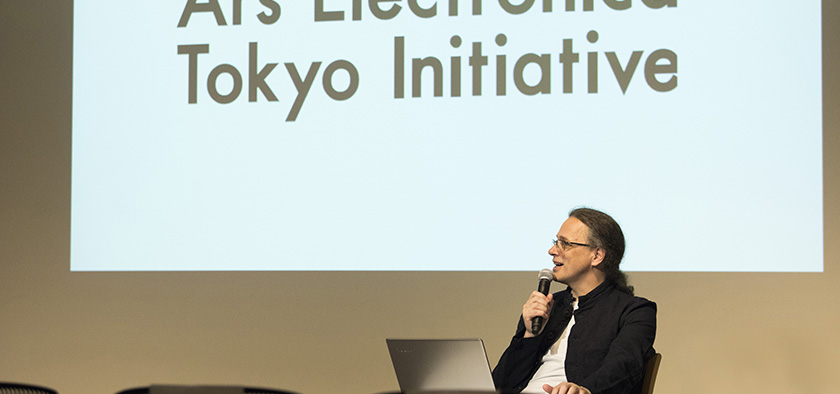
The indispensable technology in our everyday lives
We are at a time when the role of creators in society and their expertise are changing; inevitably the consciousness of every one of us is changing, and I believe the change is necessary.
This is because there is a multifold intertwining in society of the real and virtual worlds, and of the digital and analog worlds, and because the constantly-evolving technology has become indispensable in our everyday lives. How are we going to understand technology and how are we going to use it? To understand the significance of using technology and the possibilities of technology, we need to have a flexible consciousness - thinking in a way that is like kneading clay and blending things together.
However, in reality, it is not so easy. Generally speaking, information about technology is simplified and it is only the stories with impact that become widely spread. One example is talk that AI (artificial intelligence) will control the earth and take over the human race. However, AI is essentially something that prompts us to think about humanness. To be able to look at things from multiple perspectives, we need the power of education.
Education that is needed for the future
I think the whole point of education is to understand the world, and to acquire the information necessary to face reality. Instead of acquiring information from separate subjects like geography and history, what will become more important in education is to understand how the world was made through the interconnection of everything; the vital thing is to develop perspective and wisdom so that you can connect all the different genres to one story.
I think that the knowledge people need to have now is knowledge of programming and algorithm. It's not just vital for those who are seeking to become engineers. Programming and algorithm are languages that help us to understand and connect to the world, and they will become tools in understanding the technology that will shape the world.
Things in everyday life, such as smartphones can be used as education material. Did you know that behind the simple steps in using a smartphone, there is a huge amount of invisible information swirling around? Or do you know why there are recently a lot of pop-up ads of Airbnb on the Internet?
The latest technology is coming out every day from the factories and laboratories and flowing into people's daily lives. Programming and algorithm provide the hints for understanding this technology; by understanding it, we can prepare ourselves for what will happen in the future, and we will be able to respond in a flexible way.
At Ars Electronica, we dispatch staff to local schools and universities to develop educational programs and to hold classes. These activities might help nurture creators of the future and lead to new technology. I think education is about fostering that potential.
Algorithm
A series of steps or method of reasoning to attain the right solution for a problem. Math formulas and programming can be said to be representative of algorithm; the series of steps, if taken as prescribed, will always lead to a certain result. The opposite of algorithm is heuristic, which is a method of arriving at a solution that is not necessarily perfect.
Transforming art museums into classrooms for the future
In Tokyo, there are so many wonderful showcases for design and art. But from now on, there will be a need for more places where people can have more experiences; for example, instead of just introducing artists and displaying their finished works, workshops and presentations could be held to show how the works were made and to let people think about the possibilities and challenges that lie within the process. If the whole city became like an educational center, it would pave the way for the future.
In that regard, Roppongi is an area of design and art and has many places with that kind of potential. In 2010, Ars Electronica exhibited works at the autumn event Tokyo Midtown DESIGN TOUCH; our aim was to make experience-oriented designs.
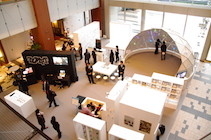
Tokyo Midtown DESIGN TOUCH
Tokyo Midtown DESIGN TOUCH is a design event that began in 2007 with the master concept of "enjoying design with the five senses." In 2010, when the event was held for the fourth time, the theme was "touching the future" and Ars Electronica exhibited futuristic works that fused design and technology. Incorporating experience-oriented designs, the works included "The Eyewriter", a device that draws pictures on a screen by tracking eye movements, and an interactive installation called "Shadowgram" that visually expresses people's thoughts on social issues.
I think the art museums and design facilities in Roppongi should take on a new role of becoming classrooms for the future. Of course, that role is what I believe Ars Electronica also needs to fulfill.
Earlier, I mentioned the potential of public space; on holidays many people walk through the open spaces in the grounds of Tokyo Midtown and Roppongi Hills. There seems to be many possibilities for using these open spaces. I hope that opportunities will be found to use them to properly show art, design and technology, and offer new experiences to people. I'm sure that the flow of pedestrians will slow down in a positive way, and that the spaces will become the new face of Roppongi.
Asking questions to get answers
What is art and what is design? I could talk for a long time about that. (laughs.) In a word though, I think that art is about discovery and design is the art of applying and utilizing that discovery.
What is common to both art and design is that they ask questions. Living in this world, it's important to ask the right questions. Active participation is encouraged when people have the mindset of setting up challenges and asking creative questions on a daily basis. By thinking about the same questions with other people, it is possible to hold dialog and overcome differences. Art, design and technology can be the starting point for people to ponder questions. When questions are asked, the answers come.
Editor's thoughts
AI, programming, algorithm, technology.. . While all these were familiar words for me, I had felt they were concepts existing far beyond my realm. Listening to Mr. Stocker however, the distance between these concepts and myself seemed to become closer and closer. I also wished I could visit Linz. I have a feeling that if I go to that city and experience Ars Electronica, a lot of questions will come to my mind.(edit_nanae mizushima)




